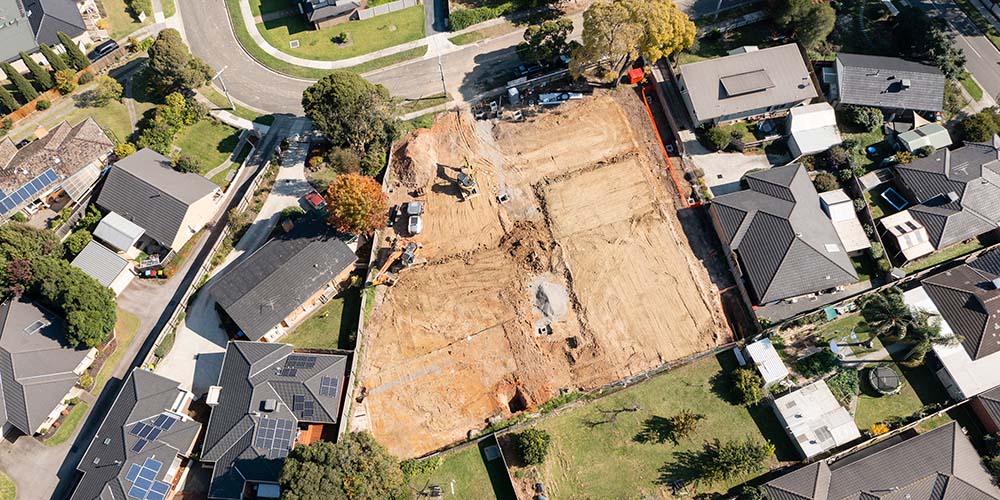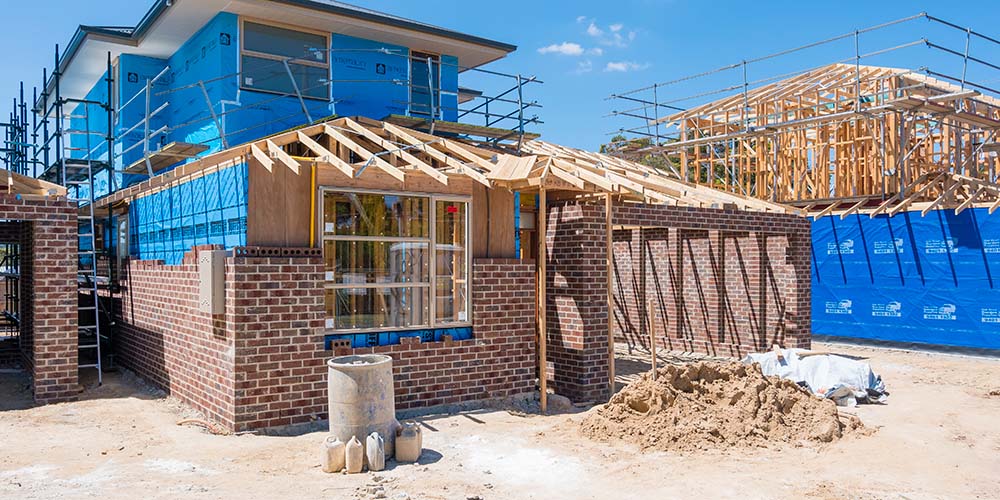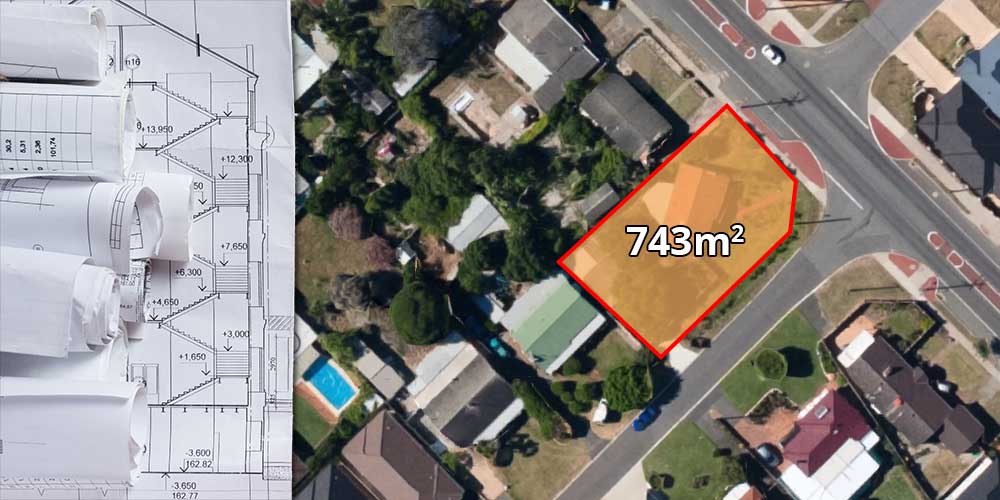
Variations and Concessions to the Residential Design Codes WA
Did you know that there are concessions and variations you can apply to planning rules in WA, that allow you to bend the rules a little? This article will give you a brief overview of these design concessions and variations, and how to apply them. It is essential to your success as a developer that you learn about these and how to apply them. If you know these tricks of the trade you will be able to see development potential that other people miss, and even pick up very undervalued sites off unsuspecting sellers.
In Western Australia, the WAPC (Western Australian Planning Commission) centrally administers all subdivision applications, and assesses them against the residential design codes WA. All subdivision applications are received and reviewed by the WAPC in consultation with relevant stakeholders (Local Government, Western Power, Watercorp, etc), in order to give a determination accepting or rejecting the subdivision application. As aforementioned, an important function of the WAPC is to ensure that the lot designs comply with requirements of the zoning for the lot in question, as stipulated by the Residential Design Codes WA, or “R-codes” as they are known. They dictate statutory requirements for things like lot size minimums, averages, and street frontages. Additional Local Government planning policy requirements can sometimes supplement the requirements of the Residential Design Codes.
When subdividing land in Western Australia, it is important to understand that there are concessions and variations that can be applied when designing a subdivision and compiling an application. It is important to understand these and how they are applied and interpreted- they can help get your application over the line if correctly interpreted. A few of the most important concessions and variations available are discussed in this article for you to keep in mind for the design stage of your next subdivision, that you can consider prior to submitting your application. You can learn about these in detail in our books and training courses.
The 5% rule
The first concession of use when designing a subdivision is the 5% rule. A 5% variation to the lot size can be applied to a single lot in the proposed subdivision, and/or to the average site area overall. This can help you get over the line if you are just short a few square meters to have a compliant overlay for a subdivision application. It is important to note that the 5% variation to minimum can be applied to a single lot in the application, not all of them, and in doing so cannot vary the average by more than 5% if you are applying for a variation to the average overall as well. The 5% variation is not supported if you apply it to a battle-axe lot, as stipulated in Development Control Policy 2.2 (DC2.2).
Corner Lots Concessions
For the purpose of calculating lot sizes of corner lots in subdivision applications, the “truncation” area, to a maximum of 20m2, may be added.
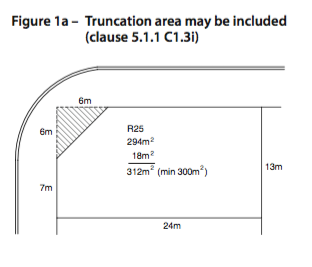
A residential design code WA concession diagram for corner lots
You can use this with the 5% variation to play around with configurations on tricky corner lots. A further concession can be applied to corner lots courtesy of Development Control Policy 2.2. As well as providing guidance on a number of other residential subdivision planning matters, the Policy document made provision for variations, greater than those allowed for in the 5% rule. The interpretation is thus: corner lots in residential areas without frontage to state or regional roads zoned up to R35 no longer need to meet the lot size average, only the lot size minimum. This has unlocked considerable development potential on sites across the Perth metropolitan area for subdivision projects. It is important to note that the concession does not apply to lots over R35 (and the lot in question must have a single residential coding, not be dual coded), and that this concession cannot be used in conjunction with other concessions provided for in the R-codes. You cannot apply DC2.2, the 5% rule and add the truncation to you lot calculations. Also note that to be considered a corner lot, the legal definition requires the lot to have frontage to two differently named streets or roads. Corner lots that do not meet this criteria will still have an application considered on its merits, but there is no guarantee of approval. Corner lots are discussed in detail in our article on corner lots and in our training courses.
Battle-axe Lot Concessions
When assembling a subdivision application for a battle-axe configuration development, there is a special concession often overlooked (but not always available). If the rear battle-axe site adjoins or abuts a right of way, reserve for open space, pedestrian access, school site or equivalent, half the width (to a maximum of 2 meters) may be added to the site area of the rear battle-axe lot.
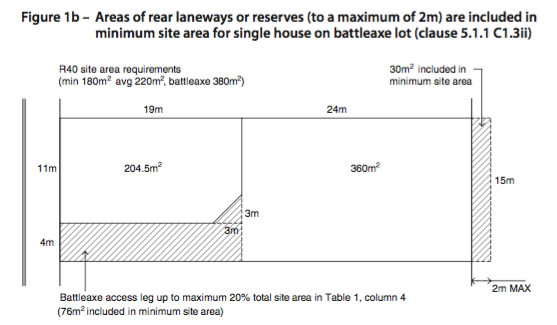
A residential design code WA concession diagram for battleaxes
It is important to note this concession cannot be applied to non battle-axe configuration lots (corner, side by side, etc.).
Local Planning and the Residential Design Codes WA
It is worth reviewing the Local Planning Policies or Scheme Texts of Local Governments (or “Councils”). Dependent on the location of your property, the locality it is in, its size and type, and the zoning it has, Local Councils may provide further concessions to you to unlock further subdivision development potential. This can include:
- Dual or dual density zoning (ie R20/50, explained more in this R-Code Zoning Definition article)
- Being part of Precinct or Area plans, where housing strategies provide concession to r-code requirements, such as reductions in open space requirements
- Bonus densities applicable to corner lots (currently in councils of Belmont, Bayswater, Kalamunda and Gosnell’s)
It is an important to note here that many local governments applying addition planning concessions to subdivision applications for corner lots are aware that people are buying corner lots and attempting to amalgamate them with adjoining corner lots to create “super corner lots” and apply concessions to the whole site. These applications are generally not supported so exercise caution if you are considering this approach.
Would you like some advice on applying concessions and variations to your site to unlock hidden development potential?
When you need a little (or a lot) help with your property development, remember we’re here to help. An hour or two of a professional consultants time can be very helpful, particularly if your own research has taken too long or you are not sure you even have the right answer to your questions.
Would you like to know more about applying Variations and Concessions to the Residential Design codes of WA ?
Applying concessions and variations to planning rules and regulations to maximise development potential and returns is explained in detail, with worked examples, in our 225 page Infill Property Developer Guide-book and correlating Online Course.

